#dr deutsche reichsbahn
Text
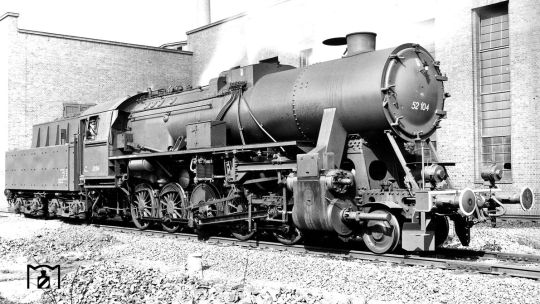
Locomotive DR number 52 104 in Dresden Friedrichstadt (1943)
The brand-new locomotive number 52 104 (Krauss-Maffei, acceptance on February 27, 1943) in its first home at the Bw Dresden-Friedrichstadt. After 1945 she stayed in Poland and ran there as Ty 2-93. A main inspection on March 8th, 1949 in the former RAW Bromberg (ZNTK Bydgoszcz) is documented. It was not until May 15, 1990 that she was removed from the inventory lists. (03/03/1943) Photo: Werner Hubert via Eisenbahnstiftung Joachim Schmidt.
#ww2#dr deutsche reichsbahn#dresden-friedrichstadt#locomotive 52 104#series 52#baureihe 52#bydgoszcz#retired 1990
14 notes
·
View notes
Text
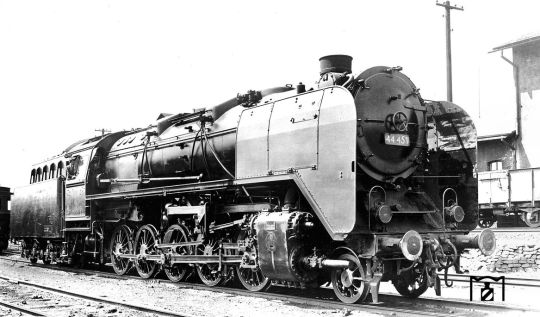
Lok DR 44 451 in Reichenbach (1941)
Locomotive number 44 451, built by Henschel in Kassel, completed its successful test drive on the ramp from Göttingen to Dransfeld on October 15, 1941. On October 16, 1941, acceptance was carried out by the Reichsbahn repair shop in Göttingen. When she arrived at her first home office in Reichenbach, she was expected by Werner Hubert and photographed there. After the war it was in Poland and was redesignated as Ty 4-23 on 09/01/1946 according to the designation plan of the Soviet Military Transport Administration. It was retired on June 16, 1975. (10.1941) Photo: DLA Darmstadt (Hubert) via Eisenbahnstiftung Joachim Schmidt.
4 notes
·
View notes
Text
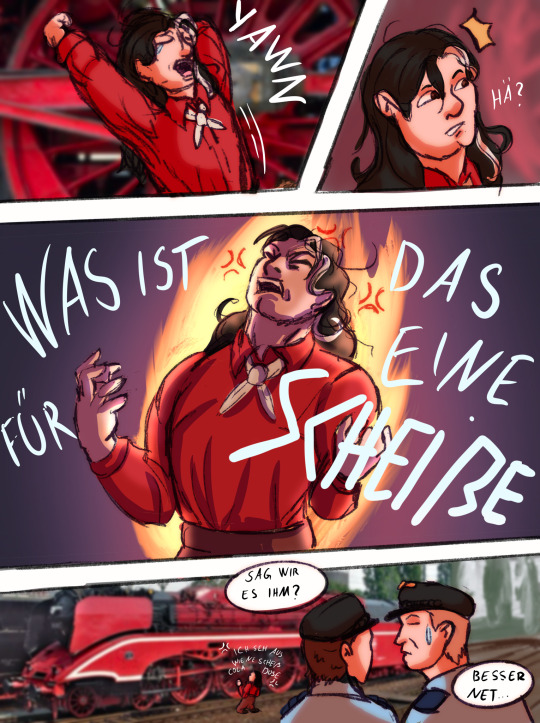
The one time Heinrich was red
Translation:
Hein: huh
Hein: WHAT IS THIS CRAP
man left: Do we tell him?
Man right: Rather not
Mini text: I look like a damn can of coke
#ttte#thomas and friends#ttte humanized#ttte human au#ttte oc#akagi’s ocs#Heinrich the Pride of the DR#dr br 18 201#dr 18 201#18 201#deutsche reichsbahn#ttte shitpost#ttte comic#Behold the big Coca Cola can on wheels#Ah yes the good old Roco marketing stunt#fun fact the red on the wheels and body are different shades#Feral himbo Heinrich lol
39 notes
·
View notes
Text

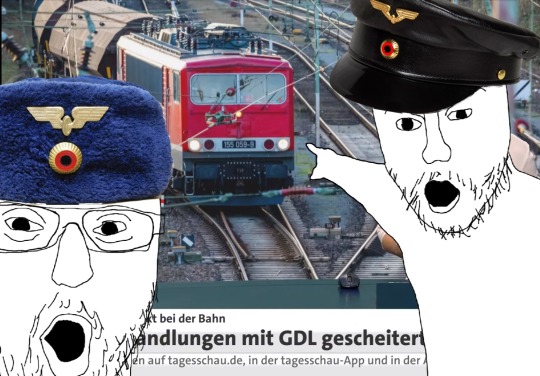
@femboytrain
@punalippulaiva
#public transit#deutsche bahn#trains#ddr#nie wieder cdu#east germany#gdr#deutsche reichsbahn#DR 250#DB 155#strikes#union#GDL#tagesschau
9 notes
·
View notes
Photo

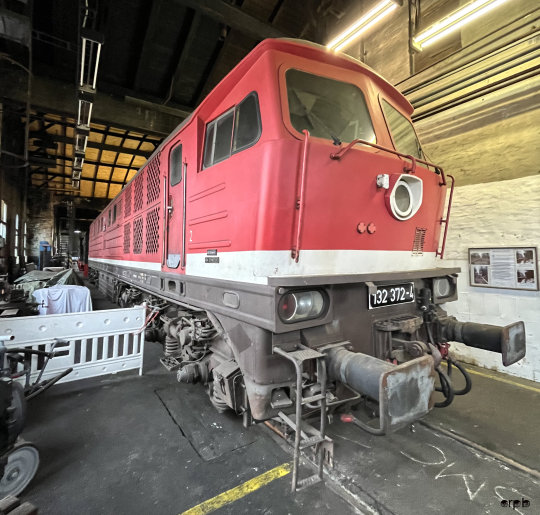
132 372-4 ‘Ludmilla’ im Mecklenburgischen Eisenbahn- und Technikmuseum Schwerin
Die in der Lokomotivfabrik Luhansk Луганський тепловозобудівний завод (ЛТЗ) (ehemals Lokfabrik ‘Oktoberrevolution’ Woroschilowgrad (UDSSR)) im Jahr 1976 gebaute dieselelektrische Lok war von Anfang an im Bw Schwerin beheimatet. Nach Zusammenlegung der Deutschen Bahn (DB) und Deutschen Reichsbahn (DR) 1992, landete diese 3000PS starke Maschine 2002 nach der Ausmusterung schon in Mukran (Insel Rügen) zur Abstellung. Vereinsmitglieder der Mecklenburgischen Eisenbahnfreunde Schwerin entdeckten die Lokomotive dort und kümmerten sich erfolgreich um den Erwarb und den Erhalt dieser kraftvollen Lokomotive.
132 372-4 'Ludmilla' at the Mecklenburg Railway and Technology Museum in Schwerin.
Built at the Luhansk locomotive factory Луганський тепловозобудівний завод (ЛТЗ) (formerly the 'October Revolution' locomotive factory in Voroshilovgrad (USSR)) in 1976, this diesel-electric locomotive was based at the Schwerin depot from the start. After the merger of the Deutsche Bahn (DB) and Deutsche Reichsbahn (DR) in 1992, this 3000 hp locomotive ended up in Mukran (Rügen Island) for retirement in 2002. Club members of the Mecklenburgische Eisenbahnfreunde Schwerin discovered the locomotive there and successfully took care of the acquisition and preservation of this powerful locomotive.
#dampflokblog.de#132 372-4#BR132#BR 132#Ludimlla#Diesellok#diesel locomotive#Diesel#locomotora#locomotive#lokomotywa#Eisenbahnmuseen & Betriebshöfe#Railway Museums & Depots#Eisenbahn#Railway#Diesel-Dienstag#Elektro-Locomotive#鉄道#локомотив#Mecklenburgisches Eisenbahn- und Technikmuseum#Schwerin#BR232#BR 232#V300#Lokomotivfabrik Luhansk#Луганський тепловозобудівний завод (ЛТЗ)
19 notes
·
View notes
Video
Merzig Saarland Germany 29th April 2018 por loose_grip_99
Por Flickr:
Deutsche Reichsbahn (DR) Class 03 Pacific 1010 arrives at Merzig station in the rain with the 11.38 from Saarbrucken during the Rhineland-Palatinate Dampf Spektakel. We took this train back to Trier. The first 03.10 was built in 1939 and 140 were planned but as a result of WWII and the switching of production to 'war essential' goods, only 60 engines were completed by 1941. They were built as streamliners mainly by Borsig, Krupp and Krauss-Maffei but post-war the streamlined bodywork was subsequently removed. Both DB and DR Class 01-10s were rebuilt in the 1950s & 60s. Between November 1965 and September 1966, all DB Class 03.10s were withdrawn, retired and scrapped while the DR engines, including 03-1010, were withdrawn by 1980.
11 notes
·
View notes
Video
Deutsche Reichsbahn (German State Railways) - DR Class 61 4-6-6T steam locomotive Nr. 61 002 (Henschel Locomotive Works, Kassel 23515 / 1939) by Historical Railway Images
Via Flickr:
This locomotive was rebuilt in 1961 as DR 18201 de.wikipedia.org/wiki/DR-Baureihe_61
#train#steam#locomotive#Dampflok#Henschel#HWZ#DR#DRG#Eisenbahn#Reichsbahn#Kassel#BR 61#18201#flickr#trainspam
2 notes
·
View notes
Video
youtube
BONUS: DDR Deutsche Reichsbahn 1989 Leipzig HBF DR E 18 DR 132 DR 143
3 notes
·
View notes
Text
Greenshot deutsch

#GREENSHOT DEUTSCH WINDOWS 10#
#GREENSHOT DEUTSCH SOFTWARE#
#GREENSHOT DEUTSCH OFFLINE#
#GREENSHOT DEUTSCH FREE#
#GREENSHOT DEUTSCH FREE#
If you have any doubts, feel free to share it with us. This shortcut key will help to edit the textįrom this tutorial, you can get to know the simple and useful keyboard shortcuts available for the Greenshot app. The Extra Mean Green Hot Sauce from Puckerbutt Pepper Co is called extra mean for a reason, as it come in at 9/10 on our heat scale. lime green, hot pink, yellow, navy, khaki and the more obvious convicted. deinem Bildschirm - Kurzes Review von " Instant Eyedropper" (deutsch). and borders on social impropriety wo435 - mid 1960s Deutsche Reichsbahn DR. It opens a new message in the default email client, add the image as an attachment Compare Greenshot VS Instant Eyedropper and find out whats different. This shortcut key will help to copy the image to the clipboard It is developed by Thomas Braun, Jens Klingen and Robin Krom 1 and is published under GNU General Public License, hosted by GitHub. Easily annotate, highlight or obfuscate parts of the screenshot.
#GREENSHOT DEUTSCH SOFTWARE#
Helps to choose the location and name to save the file Greenshot is a free and open-source screenshot program for Microsoft Windows. Greenshot is a light-weight screenshot software tool for Windows with the following key features: Quickly create screenshots of a selected region, window or fullscreen you can even capture complete (scrolling) web pages from Internet Explorer. Hold down to have the object anchored in its geometrical middle You can hold this key to maintain the existing object’s aspect ratio while resizing force a rectangle to be a square), hold down while drawing Greenshot, snipping tool Microsoft Powerpoint, Microsoft Excel, Snipping Tool, Technical Writer. It is developed by Thomas Braun, Jens Klingen and Robin Krom and is published.
#GREENSHOT DEUTSCH WINDOWS 10#
Hold down while clicking elements to select multiple elements Die Snipping Tool Alternative greenshot Kostenlos Windows 10Wie Schneide ich unter Windows 7 Windows 8 Windows 8.1 und Windows 10 Einfach und schnell Bilder. Greenshot is a free and open-source screenshot program for Microsoft Windows. This shortcut key will help to show the arrow This shortcut key will help to capture the window If you choose the last one, it will handle the upload.
#GREENSHOT DEUTSCH OFFLINE#
Unfortunately, I find it more difficult to setup compared to Greenshot.Download Greenshot Shortcuts for Offline Study Here: Greenshot. Edit in the Greenshot editor (to add text or shapes) Save directly to disk Upload to imgur. In Greenshot: Hit the keyboard shortcut for selecting a region, select the region, then name the file to save it. Wer Englisch oder Deutsch bevorzugt, kann sich dies sparen, da die beiden Sprachen bereits integriert sind. To screenshot using snipping tool, I first have to open it (already have it on my taskbar for easy access), select New, drag the box to select region, click Save icon, then finally, name the image and save it. I was using the default Windows snipping tool but found it very inefficient for saving tons of images. There doesn't seem to be much discussion in recent year.Ĭurrently, I'm using Greenshot. thorax, and of the first abdominal segment dark green, shot with bluish and purple, rest of body ochraceous. The problem is, all the discussions I've read are from 1-5 years ago. I've also read search results from Google, although they don't really contain much information compared to reddit. Soft32 is also available in Deutsch, Espaol, Franais, Portugus, Italiano. And also threads about the default Windows snipping tool. Was ist Greenshot Greenshot ist ein kompaktes Screenshot-Programm fr Windows mit den folgenden Hauptfunktionen: Schnelle Erstellung von Screenshots eines Bereichs, Fensters oder des kompletten Bildschirms es knnen auch komplette (scrollende) Webseiten im Internet Explorer abfotografiert werden. Greenshot is a light-weight screenshot software tool for Windows. So I've read almost all of the reddit threads about ShareX and Greenshot.

0 notes
Text
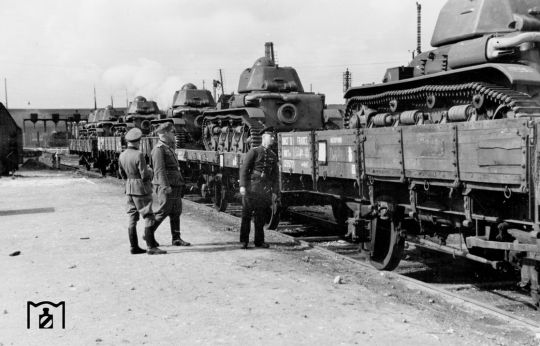
WAR TROPHIES OF THE BATTLE OF FRANCE
French Renault R-35 tanks are being prepared at Lille train station for transport to Germany. With around 1,600 built, the R-35 was the most widely used French tank during World War II. Although it was superior to most German tanks in terms of armor and armament in the western campaign, the tanks shown here are intended as "metal donations" according to the press release. Possibly the original text is due to the zeitgeist which ruled out "recycling enemy material" as it had to be inferior because one had finally defeated "the enemy". In fact, the Wehrmacht was completely underpowered and underarmed. In reality, the main part of these tanks was rebuilt and integrated into the Wehrmacht, especially since their 4.7cm gun was more powerful than the 3.7cm gun used by German tanks at the time (09.10.1940). Photo: RVM via Eisenbahnstiftung Joachim Schmidt.
18 notes
·
View notes
Text
Rübelandbahn
A while ago I promised/threatened to explain the history of the Rübelandbahn, a somewhat weird little german railway line. Today I want to do that. But I think to start with, I gotta explain Germany.

[Image: Very rough hand-drawn geographical map of Germany. The north is marked green and labelled flat, the south is marked brown and labelled mountains. At the top of the mountains part roughly in the middle of the country is an oval labelled “Harz”.]
…look, there are reasons why I never post any fan art for anything here.
The basic geography anyway. Germany is roughly rectangular and a bit taller than wide (longer in north-south direction than east-west), and in terms of landscape it’s largely divided into two main parts: The north is essentially one giant big flat plain. There’s also a bit of coast and some rivers, but generally no notable mountains or anything.
The southern half, on the other hand, is filled essentially completely with medium-sized hills and mountain ranges, the “Mittelgebirge” (literally middle mountain ranges). The higher peaks in them reach generally up to the 800-1200 m above sea level range. The specific terrain varies widely, though, with some higher ranges, some flatter ones, some large plateaus, wide river valleys and so on. There’s also a bit of alps at the very bottom, but that’s not relevant here.
The line between flat and hilly-to-mountainous isn’t straight. If you look at it from west to east (or vice versa), it starts a bit south of the north-south middle, then rises a bit north, then goes back south. At the tip of this chevron shape sits the topic of this post: The Harz mountains, the northern-most mountains in Germany.
These are a bit of an oddity among the middle mountains. The entire mountain range is very small, only about 200 km long in east-west and 60 km wide in north south direction, but it is much steeper and taller than anything around for a really long distance. It’s also apparently very interesting for geologists; if you can find a certain mineral anywhere in Germany, you can generally also find something very similar somewhere in the Harz. As a result of that, there is a long history of mining here.
So what does that mean for railways? Well, largely that they left the Harz alone. The Harz is fairly small, and it is relatively far away from all the larger cities in Germany, so for most relations, you can avoid it easily. There are some major railway lines roughly along the edges of the Harz, particularly in the valley to the west of it (containing Germany’s first high speed line Hanover-Würzburg) and south of it (a line that is mainly used for freight), but they stay within viewing distance of the actual mountains instead of crossing them. There are lines along the north and east, but those are really more local things and they don’t always follow the Harz edge closely.
But there are, or at least used to be the, mines, and since the 20th centuryalso a bit of tourism. As a result, there were a surprisingly large number of lines built into the Harz mountains, but generally not through. The only exception is the narrow-gauge network, nowadays known as HSB, which cuts through the Harz in a north-south-direction almost exactly in the middle. It runs with steam trains for tourists these days and is a lot of fun if you’re in the area. But this isn’t the line I want to talk about now.
The Rübelandbahn is a normal gauge line built into the mountains to haul stuff down, in this case in particular limestone from quarries around the towns of Rübeland and Elbingerode, down to Blankenburg at the foot of the mountains, and then further to Halberstadt via a normal flat line. There used to be many similar lines, but it’s the most impressive, and most importantly, the only one that’s still around. The mining for ore in the Harz mountains ceased in the second half of the twentieth century as the mines were exhausted from literally thousands of years of mining (the first official documents relating to mining date back to 981 CE, but archeological finds go back at least another thousand years). But the quarries around Rübeland still produce limestone today.
This railway line was originally opened under the confusing name “Harzbahn” (Harz line), as if it was the only one. Since Rübeland is on the north side of the watershed, the line follows its valley north, to Blankenburg. It is a fairly impressive for its short distance, with one really tall bridge and a switchback.
Originally it was operated with cog wheels. If you’re interested in cog wheel technology, this was actually the first case where the Abt system was used. In the 1910s, the company ordered four new heavy tank engines, the “animal class”, which were so powerful that cog wheels weren’t needed anymore. One of them, the former Mammut (Mammoth), is preserved in Rübeland today, although currently not in steamable condition.
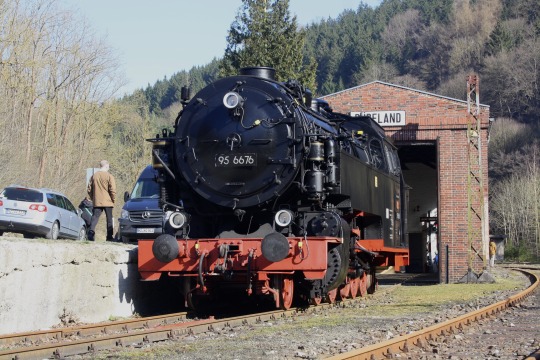
[Image: A picture of a steam locomotive Mammoth, nowadays labeled 95 6676, parked outside its locomotive shed in Rübeland]
These and the derived slightly newer Prussian T 20 locomotives used to haul a lot of limestone down the mountain.
In the 1960s, it was decided that inefficient steam locomotives needed replacing, and that more limestone should be produced. Diesel locomotives were considered, but ultimately, with the requirements, it was decided that electric would be better.
There were just two problems. One was political.
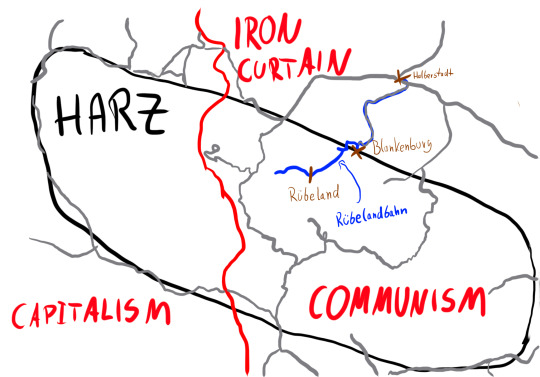
[Image: Hand-drawn map of the Harz with a red line denoting the Iron Curtain down the middle. The left is labeled “capitalism”, the right “communism”. The Rübelandbahn is drawn in blue and leads on the right side in a north-eastern direction out of the Harz. Other railway lines are drawn in gray.]
In the 1960s, we were deep in the Cold War, and Germany—as well as the entire world—was divided in two. The dividing line went straight through the middle of the Harz mountains. The Rübelandbahn itself was not affected, but it meant that the line was now, as seen from the new communist state, essentially alone at the end of the world.
The other issue is geography, and specifically the fact that everything north of the Harz is just flat and boring. The Rübelandbahn went through challenging terrain that made electrification necessary, but the lines leading away from it were flat and easy going. They have also always been fairly minor lines to begin with. There was no business case for electrifying them. In fact, they still haven’t been to this day, and I’m not holding my breath for that to change anytime soon.
The chosen solution was to electrify only the Rübelandbahn and nothing else, with the requirement to change locomotives down in Blankenburg. Stuff like that is by no means unusual around the world, but it is unusual for Germany. The main problem here is Germany’s electrification system: It uses 15 kV at the unusual frequency of 16.7 Hz, chosen because that was easier to handle in old locomotives than normal 50 Hz.
So the responsible people would now either have to build an expensive line to carry this weird 16.7 Hz electricity all the way to Rübeland, or install an expensive frequency converter there. Neither option was impossible by any means, but they were expensive. Instead, the people responsible decided to get creative: They electrified the line at 25 kV 50 Hz.
This was starting to become the new standard for new electrification systems around Europe at the time, and the railroaders in east Germany had liked the idea a lot. No more expensive converters, and just one standard voltage for everyone! Yes, it was incompatible with what West Germany was using, but in the middle of the Cold War, that was considered a feature, not a bug. In fact, there had been plans to use 50 Hz for all electrifications in the GDR. The pre-war electric rail equipment had been taken as reparations by the Soviet Union, so they were free to think of new things. Ultimately it was cheaper to buy back the pre-war locomotives from the Soviet Union than try to build all these all-new, expensive 50 Hz locomotives, so the classic 16.7 Hz was kept. But the Rübelandbahn was a chance to try again, and prove to the international world that the GDR could do 50 Hz. And then sell them 50 Hz locomotives, obviously.
For the line, a new series of locomotives was designed, the class E 251.

[Image: Photograph of a class E 251 electric locomotive in Blankenburg; this one is labelled as class 171, which was the class number they received in 1994.]
It was based on the then-standard locomotive classes E 11 and E 42, but longer, heavier, designed for tighter curves and lower top speeds. And, of course, for 50 Hz electrification. These 25 machines only ever saw service on this one line, but they were successful here, surviving until the late 1990s. Today, two are preserved. There were plans to sell the rest of the series to Romania, which also has 25 kV 50 Hz, but at fifty years old and with a top speed of only 80 km/h, they were considered not useful, and scrapped.
In the 2000s, the line went through some trouble. The quarry company had decided to hand over some of the freight contracts over to HVLE, a private freight company from Berlin. Since 1994 all german freight traffic is open access, meaning any company that has the necessary safety certificates can book train paths and run trains from anywhere to anywhere, so this was no problem in theory. However, HVLE had no 50 Hz electrics, so they ran with big diesel locomotives, like the “Blue Tiger”.
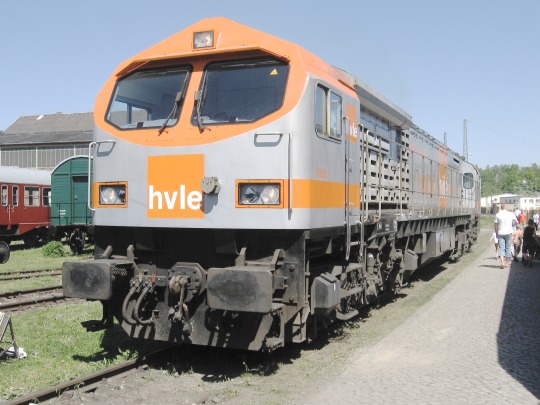
[Image: Picture of a Blue Tiger diesel locomotive in Rübeland.]
The “Blue Tiger” was a joint product of GE Transportation and Bombardier that didn’t sell well at all, but did find its home on this line. As a result, DB Netz, the owner of the line, decided it wasn’t worth the money to maintain the overhead lines anymore, so DB Cargo, the operator with the other freight contracts, also switched to diesel locomotives, in this case largely class 232 “Ludmilla” diesels built in the Soviet Union.
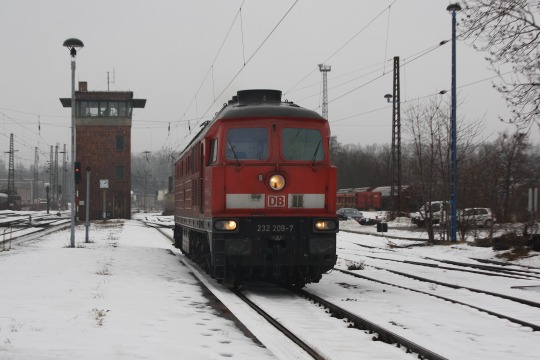
[Image: Picture of a red class 232 diesel locomotive in Blankenburg station.]
By that point diesel technology was at a point where this mountain line could work with diesels.
This proved incredibly unpopular with the people living near the line. These diesel machines are really, really loud. HVLE, who eventually took over all freight operations on the line, fitted some of their Blue Tigers with enhanced mufflers. Those did work, up to a point. I used to live next to another line where they operated, and you could always tell whether the one on the next freight train was one with or without this hush kit. Still, it was never quiet.
After years of complaints, the state government decided to jump in and paid for the restoration of the overhead lines and the power equipment. This time, for their electrification, they picked… 25 kV, 50 Hz, again. Because why not, right? You don’t need an expensive converter, and the line is prepared for it already anyway.
The main important thing is the rise of modern multi-system electrics: Any electric locomotive you’ve been able to buy for the past fifteen years can run with either of 15 kV 16.7 Hz or 25 kV 50 Hz. HVLE uses bog-standard class 185 locomotives, also known as Bombardier TRAXX 2 F140 AC, and yes, that is quite a mouthful. For the americans here, this locomotive is related to NJT’s ALP-46 and ALP-45DP. There’s several hundreds of those in Germany, and almost everybody uses them. HVLE are just the only ones who use the 25 kV mode on a line entirely within Germany.

[Image: Picture of a class 185 electric locomotive in Rübeland station.]
Oh, but changes are ahead! The 185, cheap as it is, has never been a perfect fit for the line. The problem is that it has only four axles. The total amount of pulling force a locomotive can provide is limited by the amount of weight it has on the wheels; if you put a stronger motor on, you will only get wheelspin (called slipping in the railway world). And the amount of weight you can put on each axle is limited, in Germany to 22.5 metric tons, because otherwise it damages the tracks too much. A six-axle machine would be much better, but there was none available. Now, however, there is:

[Image: Picture of a Stadler Eurodual locomotive at the Innotrans railway exhibition in Berlin in 2018, where it was parked so it was completely impossible to get a good picture of it.]
The Stadler Eurodual is a six-axle locomotive that is both a powerful diesel locomotive and a powerful electric locomotive, which can run on both 15 kV and 25 kV. HVLE are using theirs all over Germany, including on the Rübelandbahn line. It can run a train down from the mountain, through Blankenburg and all the way to basically everywhere in Germany without stopping (except to change directions at the switchback). The manufacturer also claims that it damages the tracks less in tight curves than the four-axle alternatives, as those have very cheap bogie designs generally speaking.
So just like when the cog wheel sections were removed, modern technology has once again made the differences of the Rübelandbahn irrelevant. It’s still a very impressive line, though. If you’re in the area (most likely because you’re planning to ride steam trains from HSB), check it out.
It doesn’t have regular passenger service, that was never big and finally stopped in 2004, but there are regular steam excursion trains (roughly once a month give or take), using a prussian T 20 locomotive.

[Image: A prussian T 20 steam locomotive shunting in Rübeland]
All pictures and illustrations taken or drawn by me; if you want you can use them under CC-BY-SA. You can also find this post and its images on my DeviantArt, which is all rail photography and these days rarely updated.
13 notes
·
View notes
Text

1127x696 Lok DR Nr 52 2130 (1943), blieb in der UdSSR bis 1988.
The Reichsbahn did not enjoy the 52 2130 delivered in February 1943 for long. Just two years later it was owned by the Soviet Ministerstvo putej soobšcenija (MPS). It is said to have been retired in May 1988. (1943) Photo: RVM-Filmstelle Berlin (Maey) via Eisenbahnstiftung J. Schmidt
6 notes
·
View notes
Text
Pociągiem muru nie przebijesz
Pociągiem muru nie przebijesz
Korespondencja z Berlina Wschodniego 1963 roku.
Zamknięcie granicy pomiędzy Zachodnim a Wschodnim Berlinem nastąpiło 21 sierpnia1961 roku i stworzyło duże trudności komunikacyjne. Przerwane połączenia kolejowe trzeba byłozastąpić nowymi. Związane z tym inwestycje zostały wykonane w zadziwiająco krótkim czasie.
Wybudowano krótsze i dłuższe odcinki S-Bahn (szybkiej kolei nadziemnej), dziesiątki…
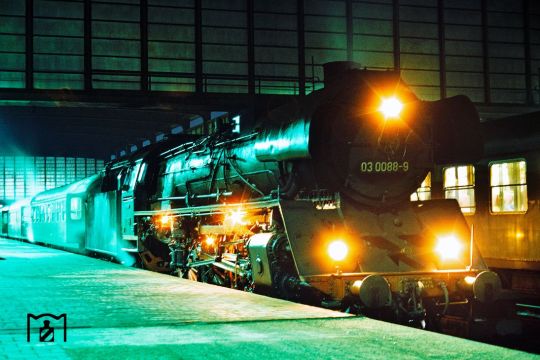
View On WordPress
#DDR#Deutsche Reichsbahn#DR#historia Europy#historia kolei#inżynieria kolejowa#koleje niemieckie#mur berliński#Niemcy#Wschodnie Niemcy
0 notes
Text

“She has him in her paw but he doesn’t mind”
My comfort couple. I love them so much. You could say Charlie corrupts Henry, but if you were dismissed and your feelings invalidated for almost two decades well someone showering in affection doesn’t sound too bad. And maybe Henry loves that Charlie is so dangerous. Who knows it works somehow. They barely fight.
#ttte#thomas and friends#ttte humanized#ttte human au#ttte oc#akagi’s ocs#ttte gijinka#ttte henry#henry the green engine#charlie the onyx engine#thomas and friends humanized#ttte human henry#humanization#humanized locomotive#deutsche reichsbahn#03x3#dr br 03#03 295#My beautiful mess of a couple#They would kill for one another and the other would lie in court
28 notes
·
View notes
Photo
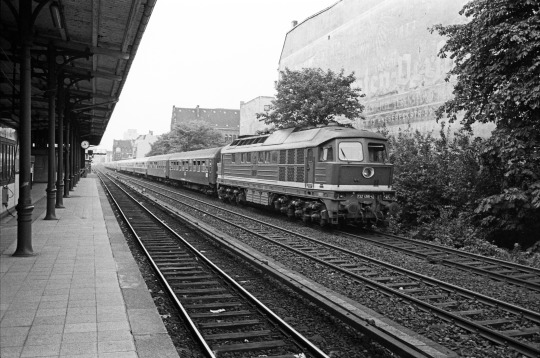
East German train running through Savignyplatz S-Bahnhof in 1986. The engine type is a Russian class 132 “Ludmilla” diesel, number 132 466. The livery was normally dark red with cream detailing. The coaches were dark green, with the ‘DR’ logo on them, for ‘Deutsche Reichsbahn’.
#analogue photography#blackandwhite#eastberlin#westberlin#DDR#communist-era#historical image#photographers on tumblr#berlin
132 notes
·
View notes
Text
Lokzug nach einer Lokparade beim Sommerfest im DB Museum Koblenz. Nach der Parade wurden alle Lokomotiven zusammengehängt und geschlossen ins Museum zurückgefahren.
Hier die vorbeifahrenden Lokomotiven:
714 015 (ex 212 160-6) (V100 / BR 212) Henschel 30846 (Bj 1964)
192 033-9 RheinCargo Siemens Smartron
185 357-0 Günni Güter Bombardier Traxx
193 309-2 Siemens Vectron
120 101-1 verkehrsrot
143 119 -6 erste verkehrsrote "143" 25.07.1997
243 002-3 Originallackierung DR
111 074 in Touristik-Lackierung
140 423-5 Pazifikblau-Beige
E50 091 grün Krupp (Bj 1963)
E10 121 dunkelblau-schwarz
E41 001 kobaltblau Henschel BBC (Bj 1956)
E03 001 rot-beige (Bj 1965)
E19 12 rot Siemens Henschel - Deutsche Reichsbahn (Bj 1938)
E93 07 (Deutsche Krokodil) (Bj 1937)
E60 10 rot-schwarz (Bügeleisen) AEG (Bj 1932)
E69 03 rot Krauss SSW (Bj 1912) "Hermine"
#dampflokblog.de#eisenbahn#локомотив#lokomotywa#locomotive#lokomotive#eisenbahnmuseen & betriebshöfe#railway museums & depots#鉄道#locomotora#eisenbahnmuseum koblenz lützel#714 015#192 033-9#185 357-0#193 309-2#120 101-1#143 119-6#111 074#243 002-3#140 423-5#E50 091#E10 121#E41 001#E03 001#E19 12#E93 07#E60 10#E69 03#Video
21 notes
·
View notes